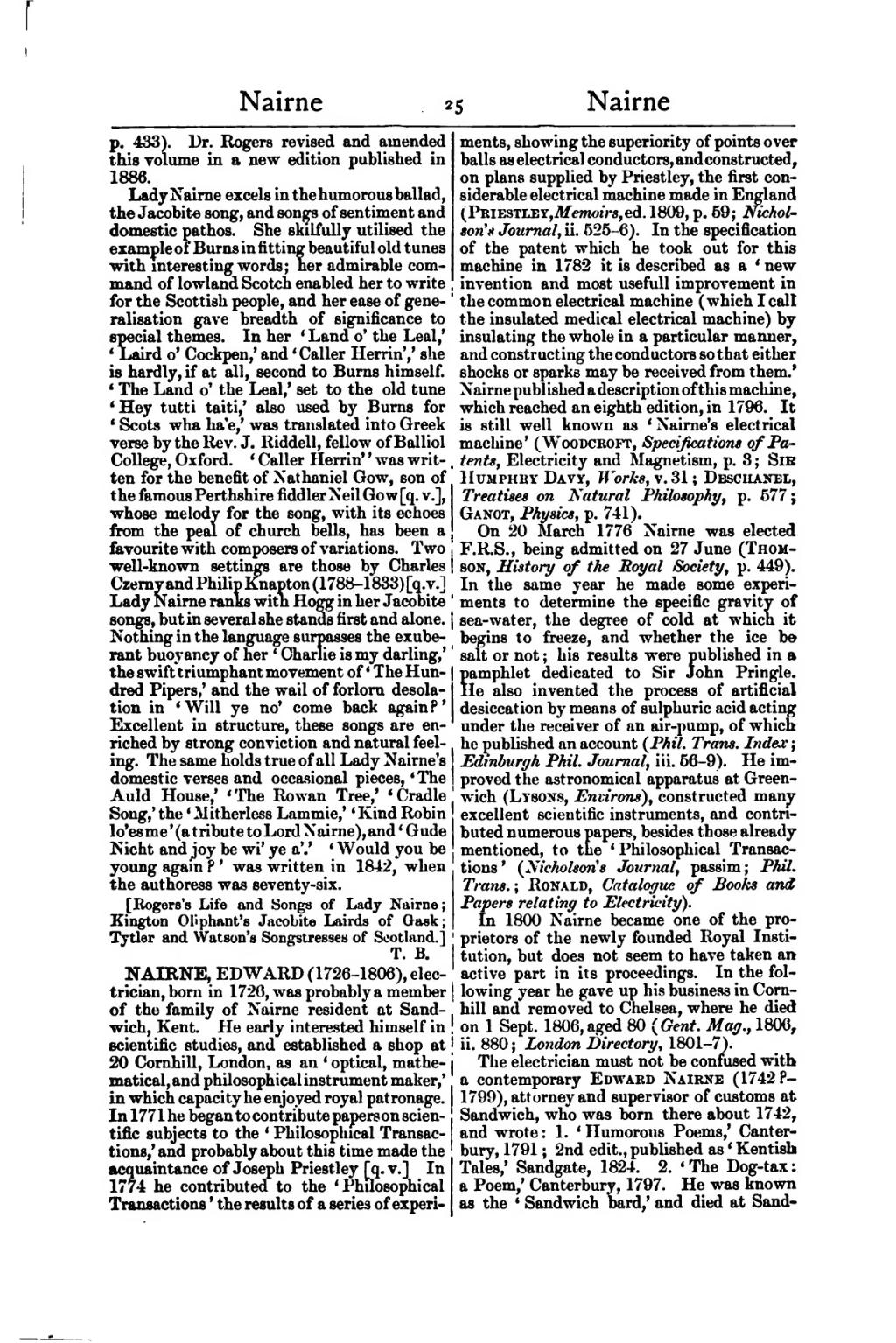p. 433). Dr. Rogers revised and amended this volume in a new edition published in 1886.
Lady Nairne excels in the humorous ballad, the Jacobite song, and songs of sentiment and domestic pathos. She skilfully utilised the example of Burns in fitting beautiful old tunes with interesting words; her admirable command of lowland Scotch enabled her to write for the Scottish people, and her ease of generalisation gave breadth of significance to special themes. In her ‘Land o' the Leal,’ ‘Laird o' Cockpen,’ and ‘Caller Herrin',’ she is hardly, if at all, second to Burns himself. ‘The Land o' the Leal,’ set to the old tune ‘Hey tutti taiti,’ also used by Burns for ‘Scots wha ha'e,’ was translated into Greek verse by the Rev. J. Riddell, fellow of Balliol College, Oxford. ‘Caller Herrin'’ was written for the benefit of Nathaniel Gow, son of the famous Perthshire fiddler Neil Gow [q. v.], whose melody for the song, with its echoes from the peal of church bells, has been a favourite with composers of variations. Two well-known settings are those by Charles Czerny and Philip Knapton (1788–1833) [q. v.] Lady Nairne ranks with Hogg in her Jacobite songs, but in several she stands first and alone. Nothing in the language surpasses the exuberant buoyancy of her ‘Charlie is my darling,’ the swift triumphant movement of ‘The Hundred Pipers,’ and the wail of forlorn desolation in ‘Will ye no' come back again?’ Excellent in structure, these songs are enriched by strong conviction and natural feeling. The same holds true of all Lady Nairne's domestic verses and occasional pieces, ‘The Auld House,’ ‘The Rowan Tree,’ ‘Cradle Song,’ the ‘Mitherless Lammie,’ ‘Kind Robin lo'es me’ (a tribute to Lord Nairne), and ‘Gude Nicht and joy be wi' ye a'.’ ‘Would you be young again?’ was written in 1842, when the authoress was seventy-six.
[Rogers's Life and Songs of Lady Nairne; Kington Oliphant's Jacobite Lairds of Gask; Tytler and Watson's Songstresses of Scotland.]
NAIRNE, EDWARD (1726–1806), electrician, born in 1726, was probably a member of the family of Nairne resident at Sandwich, Kent. He early interested himself in scientific studies, and established a shop at 20 Cornhill, London, as an ‘optical, mathematical, and philosophical instrument maker,’ in which capacity he enjoyed royal patronage. In 1771 he began to contribute papers on scientific subjects to the ‘Philosophical Transactions,’ and probably about this time made the acquaintance of Joseph Priestley [q. v.] In 1774 he contributed to the ‘Philosophical Transactions’ the results of a series of experiments, showing the superiority of points over balls as electrical conductors, and constructed, on plans supplied by Priestley, the first considerable electrical machine made in England (Priestley, Memoirs, ed. 1809, p. 59; Nicholson's Journal, ii. 525–6). In the specification of the patent which he took out for this machine in 1782 it is described as a ‘new invention and most usefull improvement in the common electrical machine (which I call the insulated medical electrical machine) by insulating the whole in a particular manner, and constructing the conductors so that either shocks or sparks may be received from them.’ Nairne published a description of this machine, which reached an eighth edition, in 1796. It is still well known as ‘Nairne's electrical machine’ (Woodcroft, Specifications of Patents, Electricity and Magnetism, p. 3; Sir Humphry Davy, Works, v. 31; Deschanel, Treatises on Natural Philosophy, p. 577; Ganot, Physics, p. 741).
On 20 March 1776 Nairne was elected F.R.S., being admitted on 27 June (Thomson, History of the Royal Society, p. 449). In the same year he made some experiments to determine the specific gravity of sea-water, the degree of cold at which it begins to freeze, and whether the ice be salt or not; his results were published in a pamphlet dedicated to Sir John Pringle. He also invented the process of artificial desiccation by means of sulphuric acid acting under the receiver of an air-pump, of which he published an account (Phil. Trans. Index; Edinburgh Phil. Journal, iii. 56–9). He improved the astronomical apparatus at Greenwich (Lysons, Environs), constructed many excellent scientific instruments, and contributed numerous papers, besides those already mentioned, to the ‘Philosophical Transactions’ (Nicholson's Journal, passim; Phil. Trans.; Ronald, Catalogue of Books and Papers relating to Electricity).
In 1800 Nairne became one of the proprietors of the newly founded Royal Institution, but does not seem to have taken an active part in its proceedings. In the following year he gave up his business in Cornhill and removed to Chelsea, where he died on 1 Sept. 1806, aged 80 (Gent. Mag., 1806, ii. 880; London Directory, 1801–7).
The electrician must not be confused with a contemporary Edward Nairne (1742?–1799), attorney and supervisor of customs at Sandwich, who was born there about 1742, and wrote: 1. ‘Humorous Poems,’ Canterbury, 1791; 2nd edit., published as ‘Kentish Tales,’ Sandgate, 1824. 2. ‘The Dog-tax: a Poem,’ Canterbury, 1797. He was known as the ‘Sandwich bard,’ and died at Sand-
